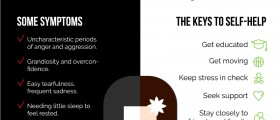
The popular misconceptions of bipolar disorder-related injuries are far from accurate. The disease is also often confused with BDP (borderline personality disorder) or psychosis.
There is a misleading trend that associates depressed teens cutting themselves with bipolar disorder – whilst nothing could be further from the truth. Bipolar is in actuality all about drastic mood swings. Self injury of the said type is most often a symptom of borderline personality disorder as well as depressive disorder rather than bipolar disorder. Other causes of similar behavior may include: trauma, emotional and sexual abuse, mental illness and traits such as low self-esteem and perfectionism as well as eating disorders.
One of the reasons people often confuse these different types of disorders is because of some of their shared traits; and those would be: impulsivity, anger and anxiety.
It's curious that self injury is often treated with (SSRI) antidepressants (i.e. Zoloft, Prozac), whilst the very same are utterly unsuitable for treating bipolar because they are known to trigger manic episodes – which only adds to the confusion of bipolar disorder self injury.
In spite of the above said, there is a number of types of self injuries related to bipolar disorder; most dangerous among those being bipolar suicides. The rate of suicides among patients with bipolar disorder goes as high as up to 30%-50% according to certain studies, although more recent studies have come up with significantly lower rates. There are two reasons behind this:
the range of people considered bipolar nowadays is significantly wider, so now not only the hospitalized are considered patients; and
the use of lithium and other medication has effectively helped treat bipolar.
So thanks to that, we now have a figure that's close to 5% suicide risk.
Statistics
The following statistics show how bipolar disorder can affect a patient's life:
bipolars are twice as likely to have gambling problems.
three times as likely to be smokers.
they have a 31% risk of drug and alcohol abuse (as opposed to 4% which is the risk for non-bipolars).
they are three times more likely to accumulate significant debts.
they are most often killed by preventable cardiovascular disease, alongside a low physical quality of life.
They have a higher rate of divorces, whilst 57% of them also has a case of hypersexuality.
"downward drift" has also been identified among bipolar patients. That means that they eventually end up with really low figures of wealth and income.

















Your thoughts on this
Loading...